Apothecary (Cannabis) Containers
Chapter 3
Chapter 3
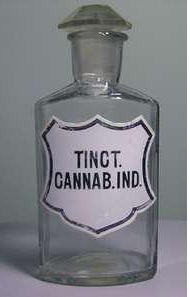
(BULK CONTAINERS)
While glass containers (bottles etc.) existed well before the 19th century, one must always keep in mind that until the latter part of that century, the glass container could easily cost more than the product that was being sold inside it. Given that cost factor, it was expected that once empty, the bottle would be cleaned and reused. It was expected and normal for the druggist to take an apothecary jar off the shelf and simply fill or refill the customer's container.
 |
 |
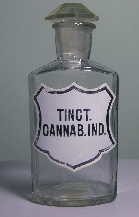 |
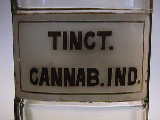 |
 |
 |
 |
 |
 |
 |
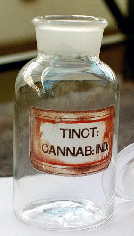 |
 |
 |
 |
 |
 |
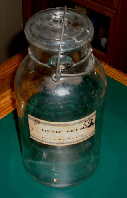 |
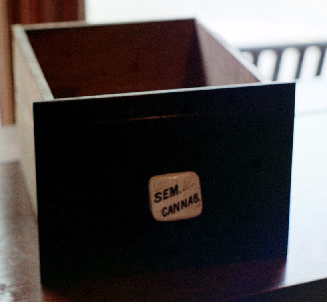 |
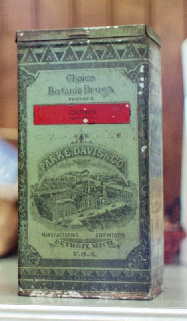 |
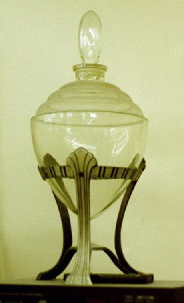 |
3.0- Apothecary (Cannabis) Containers:
3.1 - About Apothecary Containers:
Like all so many other collectors before me, I mistakenly used to think of these old pharmaceutical containers (whether ceramic jar or glass bottles) as being analogous to some of those old decorative glass cake & pie stands, that can still be found on many a mom & pop restaurant counter. They act as advertisements to remind one of dessert. They beautify the pies, make them look more desirable and, I suppose, more saleable, but other than that have absolutely nothing to do with the pies themselves. And even ignoring the fact that the pies are being oxidized, actually ruining their taste, it still makes for a lot of work just to keep them clean and maintained.
However, the more one delves into the subject, the more impressed one becomes. Some of these old apothecary containers (the show-globe's) were more than just pretty advertisements; they even served as one of our first national heath alert systems. According to the California Pharmacists Association:
"Upon entering a western frontier town, visitors would look to the [apothecary] show-globe in the drug store window to see which color liquid it contained. Red indicated the town was besieged by an epidemic."In order to truly appreciate the importance of apothecary containers, one must remember that while glass containers (bottles etc.) existed well before the 19th century until the latter part of that century, the glass container itself could easily cost more than the product that was being sold inside it. Given that cost factor, it was expected that once empty, the bottle would be cleaned and reused. It was also expected and normal for the druggist to take an apothecary jar off the shelf and simply fill or refill the customer's container.
It should also be noted that in the 19th century, and even into the early part of the 20th century, it was common practice for pharmacists to manufacture at least some of their own medicines. The pharmacist (who in many cases was also the local town general store owner) would simply ask local farmers to grow Indian Hemp (among other herbs) for them. Cannabis (the flower tops of the hemp plant) thus obtained would then be prepared and either stored in apothecary jars until sold in bulk (solid or powder) form or taken to the back room and brewed into tinctures or other medicines.
And while, realistically speaking, most of these bulk preparations would end up in the back room (most likely stored in bins and old boxes) at least those placed by the front counter would be stored in apothecary containers.
But still after all is said and done, it must be remembered that the apothecary jar's main purpose was as an early form of advertising. The more beautiful the container the better the sales. And this, at a time before brand-name products and Madison Avenue, was no small feat.
3.2 - APOTHECARIES - (A Time Line):
Leaving aside Tin's and Box containers; In general, apothecary containers can be subdivided into ceramic jars (used to store solid or powdered Cannabis flower tops) and glass bottles (used mostly for liquid tinctures). The jars normally had large lids to allow for a hand to reach in, and the glass bottles used for tinctures would have smaller bottlenecks, for poring.
Apothecary containers can range anywhere from beautifully crafted multicolor vessels to the cheapest glass jars with only a label to distinguish them. They could have been custom built in glass houses, or originally meant for other purposes (say to store peach preserves), and simply utilized for this purpose because of their size. Note: Pharmaceutical wholesale books were full of pre-printed labels for sale, just for this purpose.
I myself put the golden age for Cannabis apothecary containers between 1840 and 1910. And while Cannabis was still well in use into the 1930's, it must be remembered that by the late 19th century "brand-name drugs" slowly began to replace locally grown products. People wanted the security and presumed superior quality that a "brand name" could give them.
As more and more pre-packaged medicines made their way unto store shelves, the age of the apothecary came to an end. By the late 1930s, old apothecaries were more likely to hold candy than medicines.
3.3 - HEMP SEED OIL:
As can be seen by the photos [See Pictures], the flowering tops were not the only medical parts of the Hemp Plant that was sold in apothecary shops. [See Chapter 19 -- On Medical Hemp Seed Oil.] Although, it is unclear from the label whether this container was used to store plain Hemp Seeds or actual Hemp Seed Oil.
3.4 - APOTHECARY / BULK CONTAINER:
Not all pharmacists stored their Cannabis (as well as other bulk medicines) in Apothecary jars. As can be seen by the photos, [See Pictures] some simply used multi-drawer wooden cabinets. These cabinets looked pretty much like the ones found today in Chinese herb shops. [Reference should be made to Chapter 5 -- Cannabis Bulk Containers]
3.5 - CERAMIC JAR APOTHECARIES:
While Large (Display) Glass Bottles worked fine for liquid (Cannabis) Tinctures and such. They were impractical for use with the solid (loose-leaf) medical products also sold in bulk by pharmacies. Simply put, the bottle tops simply weren't practical (or big) enough for the job.
Thus (for obvious reasons) Ceramic Jars also found there way onto the sheaves of most apothecary shops. Like their glass bottle counterparts, they were attractive (some being hand painted works of art) and thus served as a good advertising tool, but most important of all, they had BIG lids, which allowed the proprietor to stick his/her hand in and scoop up the product.
3.6 - BULK TIN CONTAINERS:
[See Chapter 5 -- Cannabis Bulk Containers]
When dealing with antique Cannabis Tin Containers, the main problem the antique collector quickly finds is that their really aren't that many of them still around today. While Glass and Ceramic containers are still abound, Tin Containers (Mostly due to their ugliness I feel) simply weren't kept.
3.7 - PRICES AND FRAUD WARNINGS:
One would assume that as a rule of thumb the well-crafted custom-built ones, which seem to have been used mostly by pharmacies on the east coast, and in many cases were imported, would carry the most value. And to some extent that is true.
But the market is kind of crazy right now, with no rhyme or reason. So long as the label "Cannabis" can still be seen, even the cheapest lousiest-looking things are going for outrageous prices.
Prices at the present time are outrageous. If the apothecary says "Cannabis," as opposed to, say, belladonna, then be prepared to add a zero to the price tag. Even cheap glass containers (as long as the label "Cannabis" is still readable) are going for hundreds of dollars and the custom-built ones going for over $600. I myself will not even try to give a price range for them right now. As a rule of thumb, find a similar container, add a zero to the price and multiply by two, but again that is just a rule of thumb.
But if the warning "let the buyer beware" ever applied, this is it. We are dealing with a product where (in many cases) only a label stands between an old piece of junk glass and a hundred-dollar apothecary antique. And if that label reads "Cannabis," then the price goes up a couple of hundred dollars or more. And the problem is that many of those old labels are still lying around out there waiting to be used.
Without any proof, I would say that at least 50% of the cannabis apothecary jars now in circulation are out-and-out fakes. And because of the high demand we can expect that figure to grow.
Even the crafted custom apothecaries can be deceiving; I've seen one that looked so beautifully well preserved that its label could have been painted just a few years ago---and after a close examination, I would say that it was.
Only the label under glass (where the label was sandwiched between two layers of glass) type seem to be reproduction-free for now. But given the interest and steadily raising demand and increasing prices, I feel it's only a matter of time.
In general (and with great sadness) I would advise the first-time collector to avoid the area of apothecary containers altogether, until a certain degree of expertise is developed. Rule of thumb; if you can't figure out how to fake one, don't buy it.
 Back to the Last Chapter |
 BACK TO MAIN INDEX PAGE |
 On to the Next Chapter |